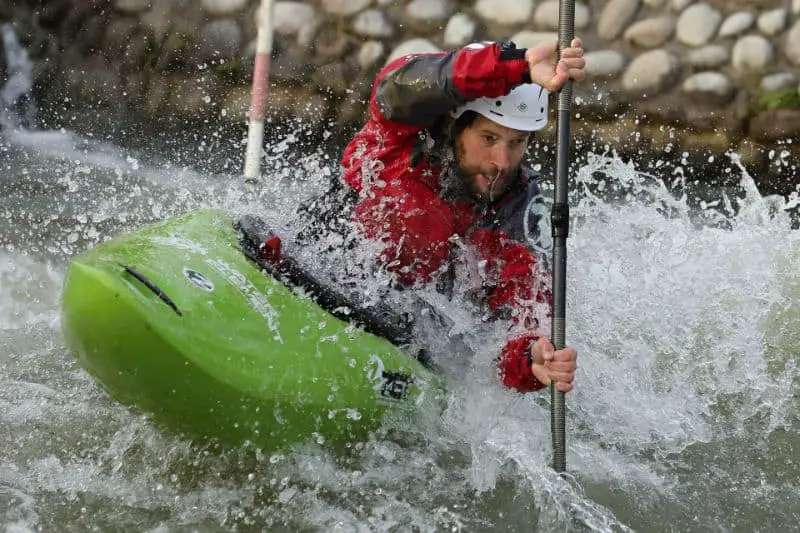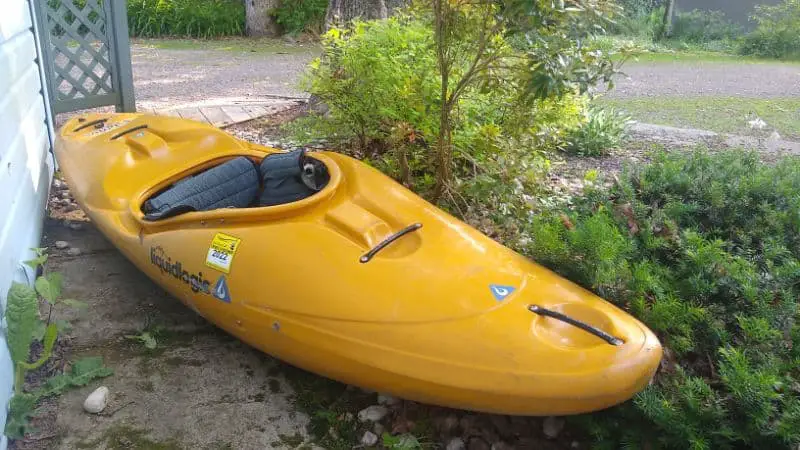
Meet the Guide!
Andy is a jack-of-all-adventures, master of none. Depending on the season, you might find him rock climbing, trail running, kayaking, skiing, mountain biking, surfing or good ol’ hiking.

Gear Guide Introduction
Who This Guide Is For:
If you’re new to whitewater kayaking and shopping for gear on a budget, this list is for you!
This Affordable Gear List is for recreational kayakers who want to explore Class 1 – Class 3 whitewater rivers. Although kayakers of all disciplines can benefit from this Gear List, it’s primarily targeted toward recreational river runners.
Whitewater kayaking is an adrenaline-fueled adventure that can transport you to all corners of the globe. But it ain’t cheap to start out in. Plus, there’s a dizzying array of options. Should you purchase the $300 neoprene spray skirt or the $30 nylon skirt being sold 50% off? What kind of kayak is appropriate for beginner to intermediate whitewater?
Let’s find out!
Who This Guide Is NOT For:
If you just dropped $500 on the latest bent-shaft, carbon fiber, feathered paddle from Werner, then feel free to click the Back button.
Visual Inspiration

Activity Demonstration
Safety & Risk
What Are the Dangers of This Activity?
You can drown. You can break a leg. You can smash your skull. Water is dangerous, people!
The two biggest hazards on rivers are holes and strainers.
- Holes are recirculating water currents, usually formed when water drops over an obstruction, like a submerged rock. Powerful recirculating currents also exist at the edges of an eddy or at the base of a low head dam. Many a kayaker has died in a hole, sucked down to the cloudy depths below.
- Strainers are formed by obstructions in the waterway, such as a cleft between two rocks or a submerged tree. Water can pass through, but a human cannot. Many a kayaker has died by getting a foot trapped between two rocks, with the strong river current forcing their bodies sideways and underwater. You can die in 2-3 feet of water if the current is strong enough.
A full description of safety while inflatable kayaking is beyond the scope of this article. Dangers include everything from drowning to hypothermia to bacterial infection.
Here are several of my personal recommendations:
- Wear a helmet! ‘Nuff said.
- Wear a PFD life jacket. Also ‘nuff said.
- Tell someone where you’re going. And preferably, don’t go alone!
- If the water’s cold, wear a wetsuit. The shock of cold water alone can stun your muscles and render them partially immobile, leading to drowning.
- When in doubt, scout. Never run a rapid you aren’t familiar with.
- If you fall out of your craft, float with your feet pointing downstream, your head out of the water, and your arms guiding you.
- Bring a whistle and know the accepted signals for calling for help. Better yet, bring a GPS tracker.
- Double-check your watercraft. Check for holes and other damages before and after every voyage.
- Hypothermia can set in the ’50s or ’60s! Water conducts heat away 25x faster than air!
- Wear your helmet and PFD!
- A bombproof roll is the most important technique.
- Don't go alone.
- Know the proper technique for a wet exit, hole escape, and foot entrapment.
What Is Whitewater Kayaking?
Squeezing into a whitewater kayak is like entering a time machine or wearing a jetpack: It can transport you to a world you didn’t know existed!
Unlike sea kayaking or flatwater kayaking, whitewater kayaking is all about the rapids. Here is the international rating system for whitewater rapids:
- Class I: Gently moving water with a few riffles. Few or no obstructions.
- Class II: Easy rapids with smaller waves and clear channels. No scouting required.
- Class III: Rapids with large, irregular waves and holes. Often requires precise maneuvering and speed control. Scouting often recommended.
- Class IV: Long, difficult rapids with constricted passages that often require complex maneuvering. Lots of holes and recirculating features. Risk of life and limb. Scouting often required.
- Class V: Extremely difficult, long, and very violent rapids with highly congested route. Severe risk of life and limb. Scouting from shore required.
- Class VI: Nearly impossible. Expert terms only. Not commercially raftable.
New kayakers begin in Class I-II water, but with practice, most kayakers become comfortable in Class III and some Class IV terrain. Class IV+ and above is reserved for the experts!

There are many styles even within whitewater kayaking.
- Slalom racing: Based on the Olympic sport, slalom kayaking is all about speed, speed, speed. Competitors kayak through a turbulent slalom course where their technique is put to the test.
- Playboating: Playboating is all about the waves. These kayaks are designed to surf, flip, spin, and enjoy the waves and holes that send most of us scurrying for shore!
- River running: The heart of recreational kayaking, river running is all about shooting the rapids, catching the eddies, boofing the falls, and otherwise making your way down the river.
- Creeking: Sometimes considered a subset of river running, creaking is all about tight, steep, technical terrain, including waterfalls.
This guide is about easy-to-moderate whitewater kayaking, from Class I to Class III. You’ll run creeks and rivers, enjoying the wave trains, catching the eddies, and surfing the holes. Just stay out of the keeper holes and stay away from fin rocks!
Affordable Gear List for Moderate Whitewater Kayaking
Gear List for Whitewater Kayaking
| Item | Price Range | Notes |
|---|---|---|
| Kayak | $300 - $700 (used) | $1,000 - $2,000 (new) | See Gear Notes |
| Paddle | $50 - $200 (used) | $100 - $400 (new) | See Gear Notes |
| Spray Skirt | $75 - $300 (new) | See Gear Notes |
| Helmet | $20 - $100 | Kayaking or multi-sport helmet rated to BS EN 1385:2012. |
| Personal Flotation Device (PFD) | $20 - $100 | USCG Type III or V most popular |
| Wetsuit | $50 (Used) - $300 | See Gear Notes |
| Nose Clip | $5 | For practice when rolling! |
| Whistle | $5 | For signaling for help! |
| Sunscreen | $5 | You burn faster on the water! |
Gear Advice
Whitewater Kayak
If you’re entering whitewater kayaking on a budget, you have no choice but to buy a used kayak.
Virtually all the kayaks you find at Big Box retailers, even the sit-in kayaks, are designed for flat and slow-moving water. A few can be taken out to the ocean surface or Class II rivers, but they’re not made for Class III whitewater and above. Most of these would be considered fishing or touring kayaks.
Unfortunately, a purebred whitewater kayak costs about $1,000. If that’s too rich for your blood, buy used. That’s what I did!
The good thing about a used kayak is that, unlike a car, it doesn’t have a mileage limit. Contrary to what you might think, the biggest enemy of a kayak isn’t rocks; it’s actually sunlight. Storing your kayak outside unprotected can halve its lifetime!
P.S. You may need float bags if your kayak gets easily swamped.

Paddle
Similar to buying a boat, your best bet is to buy a used whitewater kayak paddle.
There are some significant differences between recreational kayak paddles and whitewater kayak paddles.
- Larger, shorter, flatter blade. The blade of a whitewater kayak tends to be wider for greater power and shorter for less draft. Most beginner kayak paddles have flat rather than spoon blades. Flat blades are easier to scull, draw, and roll a kayak with.
- Shorter length. Typical lengths for whitewater kayak paddles are 180-210 cm, with 190-200 cm being the most common. Recreational kayak paddles are significantly longer, 220-260 cm.
- Less feather. Where a touring paddle might have a 45 to 90-degree feather for minimal wind resistance, whitewater paddles are usually feathered 0-45 degrees, with 15-30 degrees being the most common. This balances the need for a natural stroke with best bracing performance.
Premium whitewater paddles are usually made of carbon fiber, feature neutral-grip bent shafts, and weigh as little as 2.2 lbs! But those are a bit rich for our blood. Just look for something with a wide, flat blade that’s the right length for your height.
Although … that’s not what I did (at first). I couldn’t find a good used paddle for a little while after I bought my first hardshell kayak. So I bought a $30 4-piece recreational kayak paddle, sawed off the blades, cut 20 cm off the shaft length, drilled new push-button holes, and had myself an improvised 200cm whitewater kayak paddle! Didn’t use it forever, but it was a cheap way to get started.

Spray Skirt
Buying a spray skirt for the first time can be confusing.
- First of all, spray skirts aren’t universal. They only fit a certain size range, and each manufacturer has their own sizing system
- Thankfully, most also have sizing charts you can reference. You’ll need to know the cockpit width and length of your kayak, which you can either measure yourself or read from the manufacturer’s specifications.
- Secondly, spray skirts fit a range of sizes. You can choose what you prefer. A tighter fit is safer in big water and playboating, since it prevents “implosion,” that is, the spray skirt essentially being ripped off the cowling. But a looser fit is much easier to put on and take off, which is very helpful if you need to do a wet exit.
- Thirdly, spray skirts have both cockpit and tunnel sizes. The “tunnel” part goes around your midriff. Again, each manufacturer has their own sizing charts.
I couldn’t find a used spray skirt that both fit my kayak AND fit my waist. I looked on Ebay, Facebook Marketplace, and Craigslist. No luck.
Which led me to my fourth question: Did I want nylon or neoprene?
- Neoprene spray skirts are better, truth be told. They are more waterproof, they hold in heat, and they don’t implode under the pressure of big waves. Unfortunately, they’re also extremely expensive. Still, buy once cry once!
- Nylon spray skirts are much cheaper. They’re designed for recreational or touring kayaks. They’re best at keeping out wave spray, not withstanding big waves. Plus, all nylon spray skirts require seasonal DWR treatments to maintain their waterproofing qualities. Nevertheless, a high-quality nylon spray skirt can suffice for easy Class 1-2 whitewater kayaking.
I asked around trying to find a factory second neoprene spray skirt. Unfortunately, there was nothing on Ebay, Facebook Marketplace, or any local outdoor goods retailer that fit me and my boat.
So I bought a Level Six Excursion nylon spray skirt for 30% off. It’s not completely waterproof, and I wouldn’t trust it above Class 3, but it stays put during a roll, and I got it for $39!

Wetsuit
Other places on the web will tell you, in great detail, just what makes a wetsuit good or bad. I shall not rehash their advice. If you’ve never worn a wetsuit before, check out this guide.
For three-season whitewater kayaking, a three-quarters spring or sleeveless wetsuit is recommended. A 2mm or 3/2mm thickness is preferred; any thicker, and you can stifle your movement.
I would only add this: Buy used. Find three used wetsuits on Ebay, buy three of them, and keep the one that fits the best. Return the others. People commonly grow out of their wetsuits, so there are plenty on the aftermarket!
Don’t settle for the wrong wetsuit!
- A too-small wetsuit can chafe and restrict your shoulder mobility, which can cause overuse injuries.
- A too-large wetsuit A) makes you look like a penguin and B) can take on several gallons of water.


